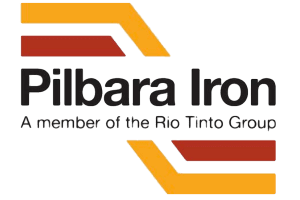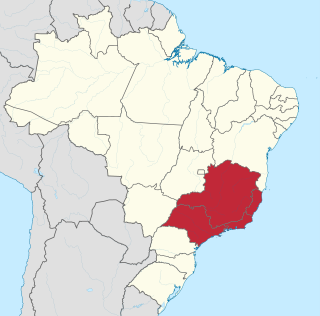
Pilbara Iron is a wholly owned subsidiary of the multinational Rio Tinto Group, that manages assets for Hamersley Iron Pty Ltd, a wholly owned subsidiary of Rio Tinto, and Robe River Iron Associates, an unincorporated joint venture between Rio and three Japanese steel companies Mitsui Iron Ore Development P/L (33%), Nippon Steel Australia P/L (10.5%) and Sumitomo Metal Australia P/L (3.5%).

Minera Escondida is a mining company that operates two open pit copper mines in the Atacama Desert, 170 km southeast of Antofagasta in northern Chile. It is currently the highest producing copper mine in the world. Its 2007 production of 1.483 million tons of the metal was worth US$10.12 billion, mainly as metal in concentrate, but some as cathode, and was 9.5% of world output and 26% of Chilean production, according to the US Geological Survey's preliminary estimates of 2007 world mine output.

Codelco is a Chilean state-owned copper mining company. It was formed in 1976 from foreign-owned copper companies that were nationalised in 1971.

The Southeast Region of Brazil is composed of the states of Espírito Santo, Minas Gerais, Rio de Janeiro and São Paulo. It is the richest region of the country, responsible for approximately 60% of the Brazilian GDP, as São Paulo, Rio de Janeiro, and Minas Gerais are the three richest states of Brazil, the top three Brazilian states in terms of GDP. The Southeast of Brazil also has the highest GDP per capita among all Brazilian regions.

Vale, formerly Companhia Vale do Rio Doce, is a Brazilian multinational corporation engaged in metals and mining and one of the largest logistics operators in Brazil. Vale is the largest producer of iron ore and nickel in the world. It also produces manganese, ferroalloys, copper, bauxite, potash, kaolin, and cobalt, currently operating nine hydroelectricity plants, and a large network of railroads, ships, and ports used to transport its products.

Nova Lima is a municipality of about 87,000 people, whose downtown is located about 20 kilometers south of Belo Horizonte, the capital of the south-eastern Brazilian state of Minas Gerais. Mining is one of the main economical activities of the city, including the extraction of Iron Ore and Gold. The most famous mine in the city is Morro Velho, a gold mine of 2,700 metres (8,900 ft) depth.
Morro Velho, also called AngloGold Ashanti Brasil Mineração, after its current owner AngloGold Ashanti, is a complex of gold mines located near the city of Nova Lima in the Minas Gerais state of Brazil.

Companhia Siderúrgica Nacional (CSN) lit. 'National Siderurgy Company' or 'National Steel Company' is the largest fully integrated steel producer in Brazil and one of the largest in Latin America in terms of crude steel production. Its main plant is located in the city of Volta Redonda, in the state of Rio de Janeiro. Its current CEO is Benjamin Steinbruch.

Brazilian industry has its earliest origin in workshops dating from the beginning of the 19th century. Most of the country's industrial establishments appeared in the Brazilian southeast, and, according to the Commerce, Agriculture, Factories and Navigation Joint, 77 establishments registered between 1808 and 1840 were classified as "factories" or "manufacturers". However, most, about 56 establishments, would be considered workshops by today's standards, directed toward the production of soap and tallow candles, snuff, spinning and weaving, foods, melting of iron and metals, wool and silk, amongst others. They used both slaves and free laborers.

Itaguaí is a municipality located in the Brazilian state of Rio de Janeiro and contains several important iron ore loading ports of the world including Ilha Guaiba. Its population was 134,819 in 2020 and its area is 273 km2. The city was founded in 1688 and lies midway between Rio de Janeiro and Angra dos Reis.

BR-262 is an east-west highway connecting the Brazilian states of Espírito Santo, Minas Gerais, São Paulo and Mato Grosso do Sul.

Mining in Brazil is centered on the extraction of iron, copper, gold, aluminum, manganese, tin, niobium, and nickel. About gemstones, Brazil is the world's largest producer of amethyst, topaz, agate and is a big producer of tourmaline, emerald, aquamarine, garnet and opal.

Raposos is a Brazilian municipality located in the state of Minas Gerais. The city belongs to the mesoregion Metropolitana de Belo Horizonte and to the microregion of Belo Horizonte.

EBX Group was a conglomerate that comprises six companies listed in B3's Novo Mercado, including Dommo Energia, MMX, OSX, and CCX. It was founded by Brazilian businessman Eike Batista, who served as chairman of the conglomerate before his arrest in 2017. The group primarily invested in infrastructure and natural resources, also having initiatives in real estate, technology, entertainment, sports, gold mining, air, and railway catering. The EBX Group was active in nine Brazilian states, Chile, Canada, Colombia, and New York City.

Eike Fuhrken Batista da Silva is a Brazilian-German serial entrepreneur who made and lost a multi-billion dollar fortune in mining and oil and gas industries. He engaged in a quest to promote Brazil's infrastructure with large-scale projects, such as the Porto do Açu.

Sierra Menera is a 31 km (19 mi) long mountain range in the southwestern end of the Iberian System.

Ferrous Resources Ltda. is a Brazilian mining company engaged in the research, exploration, exploitation, processing and marketing of iron ore.
The Saint John d'El Rey Mining Company was a British mining company that operated in Brazil in the 19th and 20th centuries. The company employed skilled miners from Cornwall and elsewhere in Britain in its gold mines in the state of Minas Gerais, and also employed black slaves.

The Iron Quadrangle is a mineral-rich region covering about 7,000 square kilometres (2,700 sq mi) in the central-southern part of the Brazilian state Minas Gerais. The area is known for its extensive deposits of gold, diamonds, and iron ore, being the source of approximately 40% of all gold produced in Brazil between the years 1500 and 2000. The deposits themselves pertain to the Minas Supergroup, a sequence of meta-sedimentary rocks initially formed in the Paleoproterozoic, about 2.5 Ga. In the 2010s, there have been two collapses of large tailings dams, which caused extensive damage and loss of life.
















